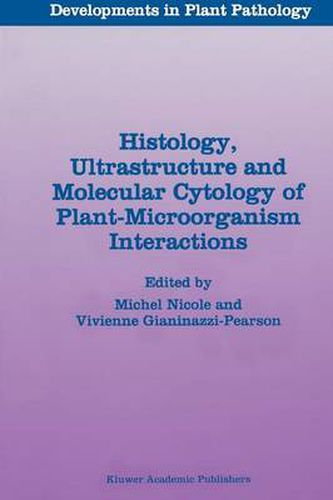Readings Newsletter
Become a Readings Member to make your shopping experience even easier.
Sign in or sign up for free!
You’re not far away from qualifying for FREE standard shipping within Australia
You’ve qualified for FREE standard shipping within Australia
The cart is loading…






This title is printed to order. This book may have been self-published. If so, we cannot guarantee the quality of the content. In the main most books will have gone through the editing process however some may not. We therefore suggest that you be aware of this before ordering this book. If in doubt check either the author or publisher’s details as we are unable to accept any returns unless they are faulty. Please contact us if you have any questions.
Plants interact with a large number of microoganisms which have a major impact on their growth either by establishing mutually beneficial symbiotic relationships or by developing as pathogens at the expense of the plant with deleterious effects. These microorganisms differ greatly not only in their nature (viruses, phytoplasmas, bacteria, fungi, nematodes, … ) but also in the way they contact, penetrate and invade their host. Histology and cytology have brought an essential contribution to our knowledge of these phenomena. They have told us for instance, how specialized structures of the pathogen are often involved in the adhesion and penetration into the plant, how the interface between both organisms is finely arranged at the cellular level, or what structural alterations affect the infected tissues. They have thus set the stage for the investigations of the underlying molecular mechanisms could be undertaken. Such investigations have been remarkably successful in the recent years, expanding considerably our understanding of plant-microorganism interactions in terms of biochemical changes, rapid modifications of enzymatic activities, coordinated gene activation, signal reception and transduction. Biochemistry, molecular biology and cellular physiology have taken precedence in the phytopathologist’s set of methods.
$9.00 standard shipping within Australia
FREE standard shipping within Australia for orders over $100.00
Express & International shipping calculated at checkout
This title is printed to order. This book may have been self-published. If so, we cannot guarantee the quality of the content. In the main most books will have gone through the editing process however some may not. We therefore suggest that you be aware of this before ordering this book. If in doubt check either the author or publisher’s details as we are unable to accept any returns unless they are faulty. Please contact us if you have any questions.
Plants interact with a large number of microoganisms which have a major impact on their growth either by establishing mutually beneficial symbiotic relationships or by developing as pathogens at the expense of the plant with deleterious effects. These microorganisms differ greatly not only in their nature (viruses, phytoplasmas, bacteria, fungi, nematodes, … ) but also in the way they contact, penetrate and invade their host. Histology and cytology have brought an essential contribution to our knowledge of these phenomena. They have told us for instance, how specialized structures of the pathogen are often involved in the adhesion and penetration into the plant, how the interface between both organisms is finely arranged at the cellular level, or what structural alterations affect the infected tissues. They have thus set the stage for the investigations of the underlying molecular mechanisms could be undertaken. Such investigations have been remarkably successful in the recent years, expanding considerably our understanding of plant-microorganism interactions in terms of biochemical changes, rapid modifications of enzymatic activities, coordinated gene activation, signal reception and transduction. Biochemistry, molecular biology and cellular physiology have taken precedence in the phytopathologist’s set of methods.